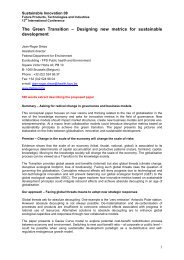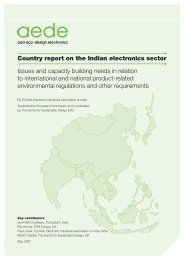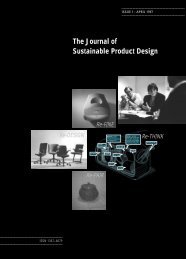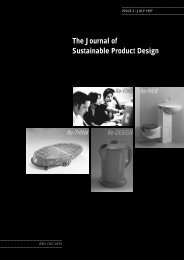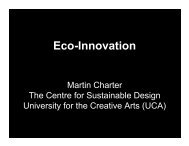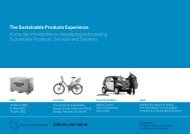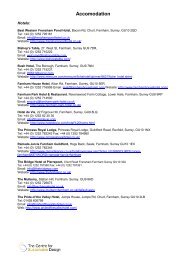acrobat JSPD 8 - The Centre for Sustainable Design
acrobat JSPD 8 - The Centre for Sustainable Design
acrobat JSPD 8 - The Centre for Sustainable Design
Create successful ePaper yourself
Turn your PDF publications into a flip-book with our unique Google optimized e-Paper software.
Figure 2: Comparsion among new and old products<br />
the low product quality and<br />
diversity; inefficiencies in the<br />
manufacturing processes; lack of<br />
technical training; lack of<br />
support from official institutions;<br />
lack of organisation and training<br />
opportunities; and lack of<br />
financial resources. <strong>The</strong> search<br />
<strong>for</strong> cheaper prices <strong>for</strong> raw<br />
materials has favoured the use<br />
of illegally harvested timber<br />
because of its lower price. <strong>The</strong>se<br />
conditions are also reflected in<br />
the products which tend to be<br />
of poor quality and are very<br />
similar in shape and style.<br />
In the region, the author – in<br />
co-ordination with a local NGO<br />
called GIRA A.C. and with the<br />
active participation of local artisans<br />
– started a project aimed at<br />
exploring alternatives to sustainable<br />
development by suggesting<br />
ways that allowed local entrepreneurs<br />
to earn adequate<br />
livelihoods through the sustainable<br />
management and use of<br />
local natural resources. During<br />
its implementation ‘eco-production’<br />
was developed as an<br />
integrated and interdisciplinary<br />
manufacturing and planning<br />
approach. ‘Eco-production’ can<br />
provide alternatives to the entire<br />
wood production cycle, including<br />
the sustainable management<br />
and supply of <strong>for</strong>est resources,<br />
improvements in the small<br />
enterprises production processes<br />
and a search <strong>for</strong> alternative<br />
market opportunities.<br />
As part of the SPD training<br />
several products were developed,<br />
Figure 1 shows a chair that was<br />
developed by artisans of Casas<br />
Blancas, a small village in the<br />
Purépecha region devoted to the<br />
production of chairs. <strong>The</strong> chair<br />
was produced as a response to<br />
the critical economic and<br />
JANUARY 1999 · THE JOURNAL OF SUSTAINABLE PRODUCT DESIGN<br />
ANALYSIS<br />
Taking into<br />
consideration<br />
that the<br />
products (old<br />
and new) are<br />
almost entirely<br />
made out<br />
of timber<br />
originated from<br />
sustainably<br />
managed<br />
<strong>for</strong>ests, the<br />
amount of<br />
timber used is a<br />
good indicator<br />
of their<br />
environmental<br />
impact at the<br />
production<br />
level.<br />
33



